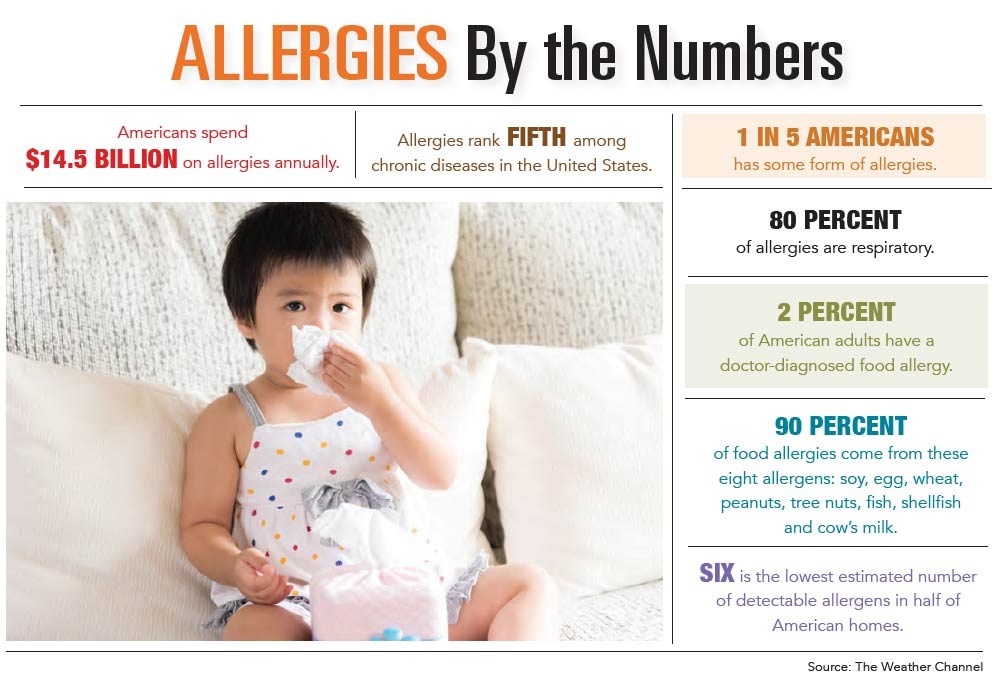Whether we’re talking pet dander, dust or dairy products, allergens are everywhere. For those who struggle with allergies on a regular basis, it can be a daunting experience. Fortunately, there are a number of things to know about allergy relief, and educating yourself for your own sake or your child’s is more important than ever.
So what exactly is an allergic reaction? It occurs when the immune system inside the body recognizes something as foreign and creates an antibody against it. Allergies can actually have a few different causes, including genetic disposition. However, parents should not simply assume that their children will share the same allergies they’ve struggled with themselves – there are plenty of instances where this is not the case.
Environmental Allergies
Common environmental allergens can include dust mites, certain varieties of pollen, pet dander or anything that enters your body through the respiratory system. Though frustrating and in some cases downright debilitating, physicians agree there is no proven way to prevent environmental allergies from developing in the first place. There are some popular theories – that exposure to cats and dogs early in life can prevent an allergy to pet dander, for example – but these studies have not been confirmed as truth. The best that families can do as far as environmental allergies is to avoid certain triggers.
“If a parent has a specific allergy, such as to grass pollen, their child may have allergies as, but it may manifest as an allergy to something different than their parent,” said Dr. Maria Streck of MUSC Pediatric Allergy & Immunology.
“Allergies are at higher risk in families, but they are not specifically heritable,” explained Dr. John Pulcini of Acadia Allergy & Immunology in Greenville.
Avoiding environmental triggers can mean everything from not sitting on a sofa that is covered in pet hair to not playing an outdoor sport during pollen season. If you must be outside and exposed to an allergen, take a shower and change clothes immediately afterward. It also helps to keep dust and mold at a minimum inside the home with regular cleanings, hardwood flooring and air purifiers.
“The immune system is ‘primed’ and ready to react when re-exposed to airborne allergens,” said Dr. Pulcini. “But as for primary prevention, nothing has been proven to prevent these allergies.”
“It is often difficult to completely eliminate exposure to airborne allergies,” said Dr. Streck. “So after we test for allergies, we educate on how to avoid triggers to their known allergens.”
Food Allergies
Food allergies are a frequent concern among parents of young children. Typical foods that cause a potentially dangerous reaction include cow’s milk, eggs, wheat, soy, peanuts, tree nuts and fish, including shellfish.
“Some allergies are more likely to be outgrown – for example: milk, eggs, soy and wheat – and some, like seafood and nuts, are more likely to be persistent,” said Dr. Streck. “If a child shows evidence by testing that they may have outgrown a specific allergy, we discuss challenging them with the food under close supervision in the doctor’s office.”
Interestingly, foods that can cause allergies are given to children earlier in life now, whereas parents a generation ago were instructed not to give these “trigger” foods to young children. In the “old days,” complementary foods – those other than breast milk or formula – were not introduced until toddlerhood.
“In the past, it was encouraged that young children avoid certain foods that are considered highly allergenic, but now we encourage them to introduce these foods sooner,” said Dr. Streck.
“The old guidelines of when to introduce complementary foods were cow’s milk at age 1, eggs at age 2 and peanuts or tree nuts at age 3,” said Dr. Pulcini. “But the most current guidelines are that allergenic foods can be introduced much sooner in a child’s diet, as early as 6 months of age.”
Parents and other adults who have been inside a school in the last few years have noted the rise of the “allergy free” classroom or lunchroom, particularly in response to peanuts and tree nuts. However, a child learning to manage his or her food allergy is a necessary skill to have in the real world, where certain triggers are not always avoidable.
“Making sure kids are safe in the classroom is extremely important. It is also important to teach children how to navigate an environment that contains their allergens so that they know how to stay safe,” said Dr. Streck. “I encourage families who have concerns to talk with their teachers and school nurses so that they feel more comfortable while their child is at school.”
“I would argue that more important than allergy free classrooms is instructing the family and school staff on how to recognize and manage allergic reactions to food,” Dr. Pulcini said.
The cure for food allergies, while still very much a work in progress, has come a long way in recent years. No doubt readers have heard of sublingual – under the tongue – and patch therapies, and immunotherapy is increasing as well.
“Because food allergies are more common, more treatments are developing,” said Dr. Streck, pointing out that peanut immunotherapy has been successful so far, and studies are developing for eggs and milk as well.
“If a parent is worried about their child having allergies, they ought to first discuss it with the primary care physician and then, if it’s necessary, referrals to an allergist and immunologist specialist is recommended,” said Dr. Pulcini. “Studies are underway to cure food allergies, and oral immunotherapy – or OIT – might be approved as early as latter 2019, and SLIT sublingual immunotherapy in late 2020, pending FDA reviews.”
By Denise K. James








